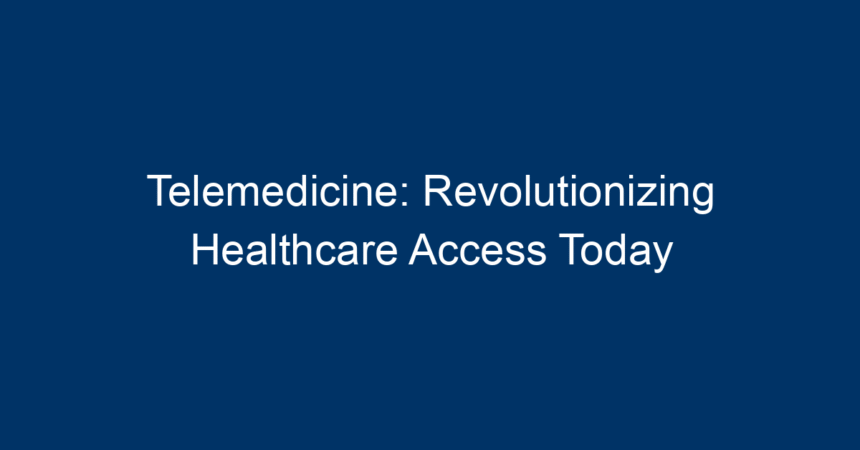In an age where technology permeates every aspect of our lives, healthcare has not been left untouched. Telemedicine stands at the forefront of this transformation, offering an innovative solution that bridges the gap between patients and healthcare providers. By utilizing telecommunications technology, telemedicine enhances healthcare access, improves patient outcomes, and reshapes the way we approach traditional medical practices. This article delves into the various dimensions of telemedicine, explores its benefits, challenges, and future potential, positioning it as a keystone in the revolution of healthcare access today.
What is Telemedicine?
Before diving deeper, it’s crucial to define what telemedicine entails. Telemedicine refers to the practice of using technology, such as video conferencing, smartphone applications, and remote monitoring devices, to deliver healthcare services at a distance. It allows healthcare professionals to assess, diagnose, and treat patients without the need for an in-person visit. This not only streamlines the healthcare process but also makes medical care more accessible to individuals regardless of their location.
The Growth of Telemedicine
The rise of telemedicine can be attributed to several key factors:
1. Technological Advancements
With the proliferation of high-speed internet and mobile devices, patients can now access healthcare from the comfort of their homes. This technological leap has made it possible for providers to communicate in real-time, ensuring timely medical interventions.
2. Increased Demand for Healthcare Services
As the global population grows and ages, the demand for healthcare services continues to rise. Telemedicine provides an efficient solution to accommodate these needs, especially in underserved areas.
3. COVID-19 Pandemic
The COVID-19 pandemic acted as a catalyst for the adoption of telemedicine. Concerns about virus transmission led many patients to seek virtual consultations. Healthcare systems rapidly adapted to this shift, recognizing the value of remote care in maintaining patient safety while providing essential services.
Benefits of Telemedicine
Telemedicine offers numerous benefits that make it a viable option for patients and providers alike:
Enhanced Accessibility
One of the most significant advantages of telemedicine is its ability to break down geographical barriers. Individuals living in rural or remote areas often lack convenient access to healthcare facilities. Telemedicine solutions allow them to connect with healthcare professionals easily, reducing travel time and expenses.
Cost-Effectiveness
Telemedicine can lower healthcare costs for both patients and providers. Patients can save on travel costs and time away from work, while healthcare providers can reduce overhead associated with in-office visits. Additionally, telemedicine often leads to fewer no-show appointments, improving overall efficiency.
Improved Patient Outcomes
Telemedicine facilitates regular check-ins and ongoing patient monitoring, which can lead to improved health outcomes. Chronic disease management, for instance, benefits from consistent monitoring, helping to prevent complications and hospitalizations.
Increased Convenience
Patients appreciate the convenience of telemedicine, as it allows them to schedule appointments that fit their lifestyles. Virtual visits eliminate the challenges associated with traditional appointments, such as long wait times and inconvenient travel.
Types of Telemedicine Services
Telemedicine encompasses various services to cater to different healthcare needs:
1. Synchronous Telemedicine
This involves real-time consultations between patients and healthcare providers through video or phone calls. This format is particularly beneficial for urgent care, mental health consultations, and follow-up appointments.
2. Asynchronous Telemedicine
Also known as store-and-forward telemedicine, this approach allows healthcare providers to review patient information and records at their convenience. It is commonly used for teledermatology and teleradiology, where images and data are sent to specialists who provide assessments later.
3. Remote Patient Monitoring (RPM)
RPM utilizes devices that collect and transmit health data from patients to their healthcare providers. This is especially useful for managing chronic conditions like diabetes and hypertension, as it enables continuous monitoring without needing constant in-person visits.
Challenges in Telemedicine
Despite its advantages, telemedicine is not without challenges:
1. Regulatory Hurdles
Telemedicine regulations vary significantly across states and countries, complicating service delivery. Ensuring compliance with laws governing patient privacy and data security can be daunting for healthcare providers.
2. Technical Barriers
Not all patients possess the technological proficiency needed to navigate telemedicine platforms. Additionally, access to high-speed internet is not universal, particularly in rural areas, which can hinder the effectiveness of telemedicine services.
3. Patient-Provider Relationships
Building a rapport between patients and providers is essential for effective healthcare. Sometimes, the virtual nature of telemedicine can create a sense of detachment, making it challenging for providers to establish trust with their patients.
4. Reimbursement Issues
While telemedicine has gained traction, reimbursement policies can be inconsistent. Providers may face obstacles in obtaining reimbursement for telemedicine services, which can affect their willingness to offer these services.
The Future of Telemedicine
The future of telemedicine looks promising, driven by continuous advancements in technology. Here are some emerging trends that could shape its trajectory:
1. Artificial Intelligence (AI) in Telemedicine
AI-driven tools are set to revolutionize telemedicine by offering predictive analytics for patient conditions and enhancing diagnostic accuracy. AI can assist healthcare providers in making informed decisions based on real-time data.
2. Wearable Health Technology
Widespread adoption of wearable health devices is on the rise. These devices can capture health metrics, such as heart rate and blood pressure, and relay them to healthcare providers, enhancing remote patient monitoring and proactive care.
3. Integration with Electronic Health Records (EHR)
Integrating telemedicine services with EHR systems will streamline patient data access for providers, enabling more informed decision-making during virtual consultations.
4. Expansion of Services
As telemedicine continues to evolve, we can expect to see an expansion in the types of services offered. This could include telepharmacy, telepsychology, and more comprehensive chronic disease management programs.
Conclusion and Actionable Insights
Telemedicine is revolutionizing healthcare access, making it more efficient, cost-effective, and patient-centered. As we navigate the challenges and embrace the opportunities that this technology presents, it’s crucial for stakeholders in the healthcare industry to remain adaptable and innovative.
Actionable Insights:
-
Leverage Telemedicine: Healthcare providers should invest in telemedicine technologies to enhance service offerings and expand patient reach.
-
Educate Patients: Inform patients about the availability and benefits of telemedicine, helping them navigate the technology involved.
-
Advocate for Policy Change: Engage in advocacy for clearer regulations and equitable reimbursement policies for telemedicine services.
- Focus on Technology Integration: Invest in the integration of telemedicine with existing healthcare technologies, such as EHRs for seamless data flow.
In conclusion, telemedicine is not just a trend; it’s a transformative force reshaping healthcare access for a diverse population. By embracing this revolution, we can create a healthier, more connected world, where everyone has access to the care they deserve.




